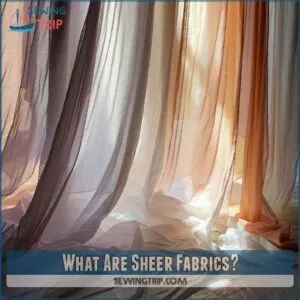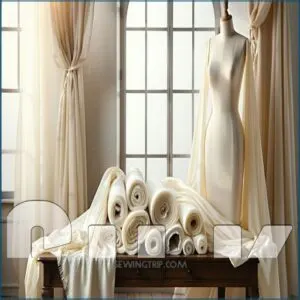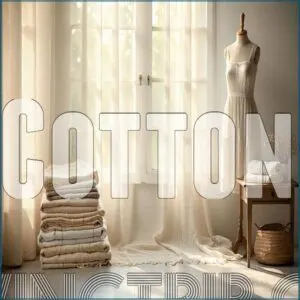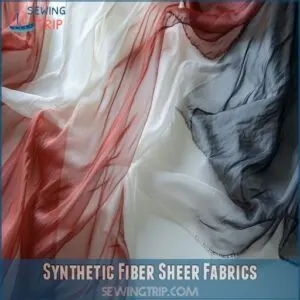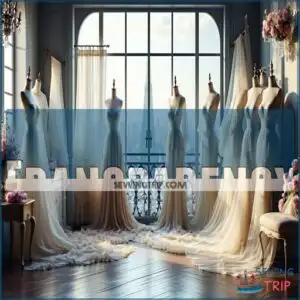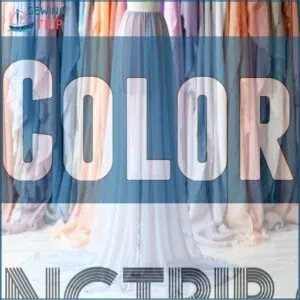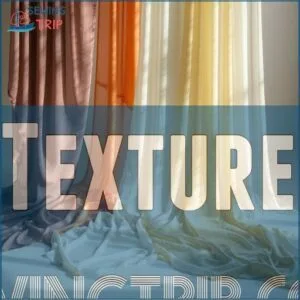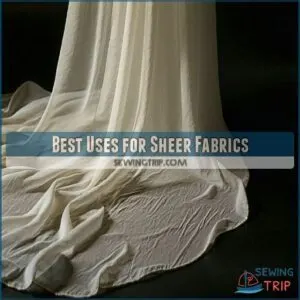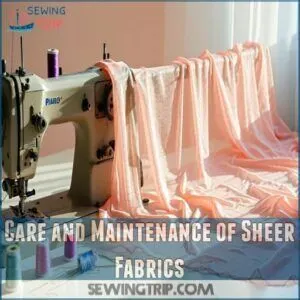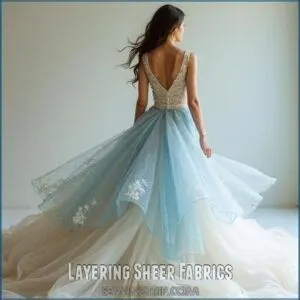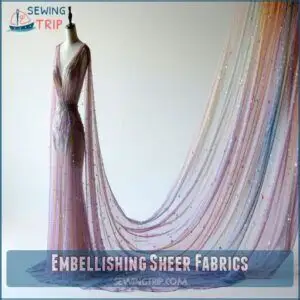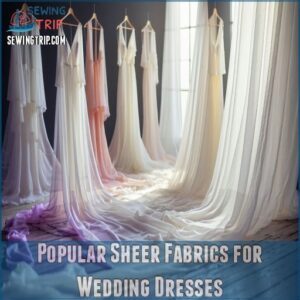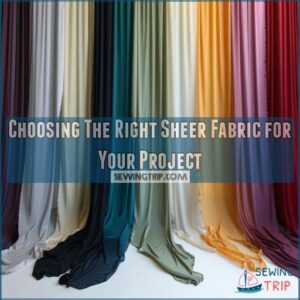This site is supported by our readers. We may earn a commission, at no cost to you, if you purchase through links.
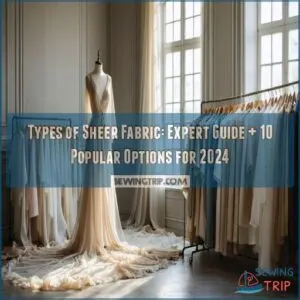
For durable, budget-friendly choices, synthetic fabrics like nylon tulle or polyester mesh shine—commonly used in bridal veils and decorations.
Each sheer fabric varies in transparency, texture, and drape, making them ideal for veils, curtains, or layered clothing.
Choosing the right type depends on your project’s needs—whether you’re after ethereal flow or structured glam, there’s a sheer fabric for the job.
Table Of Contents
- Key Takeaways
- What Are Sheer Fabrics?
- Natural Fiber Sheer Fabrics
- Synthetic Fiber Sheer Fabrics
- Characteristics of Sheer Fabrics
- Best Uses for Sheer Fabrics
- Care and Maintenance of Sheer Fabrics
- Layering Sheer Fabrics
- Embellishing Sheer Fabrics
- Popular Sheer Fabrics for Wedding Dresses
- Choosing The Right Sheer Fabric for Your Project
- Frequently Asked Questions (FAQs)
- Conclusion
Key Takeaways
- You’ll find natural options like silk chiffon and cotton voile for soft, breathable, and luxurious drape, perfect for lightweight garments and elegant decor.
- Polyester and nylon offer durable, budget-friendly sheer fabrics like tulle and mesh, ideal for veils, decorations, and everyday wear.
- Sheer fabrics range in transparency, texture, and drape, making them versatile for layering, creating flowing designs, or adding structured elegance.
- Care for sheer fabrics by using low heat, gentle washing, and precise cutting to preserve their delicate nature and achieve polished results.
What Are Sheer Fabrics?
Ever wonder what makes sheer fabrics so enchanting? These diaphanous materials dance between transparency and translucency, thanks to their unique weave patterns and thread count.
Unlike standard fabric types, sheer fabrics feature incredibly fine threads woven loosely enough to let light pass through. Whether you’re working with delicate silk chiffon or airy cotton voile, these lightweight fabrics typically range from 3 to 15 denier in fabric weights.
Understanding the types of sheer fabric is essential for selecting the right material for your project. Their semi sheer nature creates that ethereal effect you’ve seen in everything from wedding veils to elegant curtains, making them perfect for projects that need that touch of sophistication.
Natural Fiber Sheer Fabrics
You’ll find that natural fiber sheer fabrics like silk and cotton offer unmatched breathability and a luxurious drape that synthetic materials can’t quite match.
While they’re more expensive than their synthetic counterparts, these fabrics create garments and home decor pieces that feel incredibly comfortable against your skin and age beautifully over time.
Silk
Through centuries of tradition, sheer silk fabrics have captivated designers with their ethereal beauty and versatile properties. From delicate silk chiffon to structured silk organza, these fabrics offer unmatched luminosity and natural sheen.
The properties of silk make it ideal for creating translucent garments – it’s strong yet lightweight, moisture-wicking, and retains its shape beautifully. When caring for sheer silk, hand wash with mild detergent and avoid direct sunlight.
For special projects, silk tulle creates stunning veils, while silk varieties like georgette flow gracefully in evening wear. Consider testing fabric samples before starting, as different silk origins yield unique textures and sheerness levels. Additionally, learning about silk properties can help designers make informed decisions when working with this luxurious material.
Store your finished pieces on fuzzy hangers to preserve their ethereal quality.
Cotton
While silk brings luxury to sheer fabrics, cotton offers a down-to-earth charm that’s hard to beat. Cotton voile leads the pack of cotton-based sheer fabrics, with its lightweight weave patterns creating just the right amount of transparency. You’ll find that cotton blends perfectly balance thread strength and fabric density, making them ideal for summer clothing and delicate curtains.
Working with cotton sheer fabric requires attention to detail – the weave can shift under your fingers, but that’s part of what makes it so wonderfully breathable. Cotton care is straightforward: gentle washing preserves the natural fibers, and a quick press brings back that crisp, clean look you love.
From whisper-thin transparent fabrics like cotton lawn to more substantial breathable fabrics such as cotton gauze, you’ve got options. The natural fiber takes dye beautifully, creating rich, lasting colors that maintain their vibrancy wash after wash.
Synthetic Fiber Sheer Fabrics
You’ll find synthetic fiber sheer fabrics like polyester and nylon offer remarkable durability at a budget-friendly price point.
While these man-made materials might lack the natural luster of silk, they’ll give you excellent color retention and wrinkle resistance that’s perfect for both everyday wear and special occasions.
Polyester
Polyester-based sheer fabrics offer remarkable durability at budget-friendly prices. Unlike natural fibers, these synthetic textiles resist wrinkles and maintain their shape beautifully.
You’ll find polyester chiffon and polyester organza in countless colors, thanks to the material’s excellent dye absorption. The fabric’s strength makes it perfect for flowing curtains and delicate garments alike.
Semi-sheer fabrics made from polyester blends combine the best of textile science – they’re lightweight yet sturdy, easy to care for, and versatile enough for both fashion and home décor projects. For more information on sheer fabric options, exploring different types can help in selecting the right material for specific needs.
Nylon
Nylon fibers revolutionized sheer fabrics with their remarkable textile strength and versatility. When you’re working with sheer nylon, you’ll notice it’s incredibly durable yet maintains a delicate appearance.
The fabric blend often creates stunning effects in projects like wedding veils, where nylon tulle captures light beautifully. Here’s what makes nylon mesh fabrics stand out:
- Superior durability compared to natural fibers
- Excellent color retention even after multiple washes
- Consistent texture that prevents snagging
- Perfect drape for flowing garments
- Easy nylon care with machine washing
From gossamer-light nylon net curtains to structured bodices, this synthetic wonder adapts to countless designs. The sheer nylon’s resilience means your creations maintain their shape through regular wear, making it a reliable choice for both decorative and functional pieces.
Characteristics of Sheer Fabrics
You’ll find that sheer fabrics range from whisper-thin to semi-transparent, with a denier count between 3 and 15 that determines how see-through they’ll appear.
Whether you’re working with silk chiffon or cotton voile, you’ll notice these fabrics share key features like a soft drape and the ability to let light pass through their delicate weave.
Transparency
Like a butterfly’s delicate wing, sheer fabrics dance between transparency and mystery, offering varying degrees of light passage.
Understanding fabric opacity helps you choose the perfect level of see-through effect for your project.
| Fabric Type | Transparency Level | Light Passage | Common Uses | Visual Effect |
|---|---|---|---|---|
| Tulle | High | 90% |
These diaphanous fabrics create stunning transparent effects that transform with layering and lighting, making them ideal for various applications, including evening wear.
Color
Sheer fabrics aren’t just about transparency – they’re also a playground for color. From soft pastels that feel like a spring breeze to bold hues that light up a room, the possibilities are endless. With Dye Effects and Hue Variation, these fabrics can capture modern color trends or timeless classics. Their ability to hold any shade makes them perfect for crafting one-of-a-kind looks.
Layering sheer fabrics opens up a world of creativity. Think of Shade Selection and Tint Options that blend beautifully, letting you control transparency while adding depth and charm. Whether it’s a multi-layer gown or a modest overlay, you can play with color theory to make your creation unforgettable.
Here are some tips to embrace sheer fabric types with color:
- Experiment with layering for unique tones.
- Follow fashion forecasting for trendy shades.
- Consider embroidery to enhance color impact.
- Handle carefully to avoid fabric damage.
Texture
Different sheer fabrics offer distinct texture experiences, combining softness levels, thread thickness, and fiber smoothness.
Silk feels luxuriously smooth, while chiffon provides a crisp, slightly grainy texture.
Semi-sheer fabrics like voile boast a soft drape, perfect for lighter garments.
The weave pattern and fabric density also play key roles – tighter weaves offer a sleek feel, while looser ones feel more breezy.
Translucent fabrics can be layered or dyed to add visual depth and enhance their fabric texture.
To avoid fraying, pin hems or serging is necessary for long-lasting projects.
With proper care, you’ll transform delicate textures into stunning garments or decor, blending style and function effortlessly, using sheer fabric types.
The options with sheer fabric types are endless.
Best Uses for Sheer Fabrics
You’ll find sheer fabrics perfect for creating elegant clothing or adding a soft touch to home decor.
Whether it’s a flowing chiffon blouse or lightweight curtains, their versatility offers both beauty and function.
Clothing
In the context of clothing, sheer fabric has a magical way of blending elegance with versatility. Think of the grace sheer fabrics add to evening gowns, bridal wear, and even stylish everyday layers—it’s a lightweight fabric that turns heads. Popular types of sheer fabric like chiffon, lace, and organza are staples in garment design, loved by designers for their breathable fabric and flowing texture.
Regarding the creation of garments, there’s always room to innovate. Cutting patterns with precision is critical since sheer fabrics fray easily. Use sharp scissors or a rotary cutter and secure edges with double fold hems to avoid unraveling. When ironing, stick to a low setting and lift rather than drag the iron. Master these style tips, and your creations will reflect pure sophistication.
Home Decor
Sheer fabrics work wonders in home decor, offering elegance and versatility. They’re perfect for adding softness and charm to any space.
Consider these ideas:
- Window Treatments: Use voile or organza fabric for airy curtains that let in natural light while maintaining some privacy.
- Table Accents: Dress up tables with tulle fabric overlays or organza runners.
- Room Lighting: Layer sheer fabric for dreamy, diffused lighting effects.
- Fabric Draping: Add style with sheer fabric drapes over bed canopies or room dividers.
Care is key—handle gently!
Care and Maintenance of Sheer Fabrics
Caring for sheer fabrics takes patience and attention to detail to avoid damage like fraying or stretching.
With the right techniques for cutting, pressing, and sewing, you’ll keep these delicate materials looking flawless.
Cutting and Sewing
Sewing with sheer fabric can feel like taming a wisp of smoke—it’s delicate but worth the effort.
First, fabric placement is key: lay your sheer fabric on a flat, stable surface to avoid shifting. Use sharp sewing scissors or cutting tools like rotary cutters for precision. A cutting machine can also be a lifesaver for intricate designs. Understanding what are sewing shears is essential for selecting the right tools for your project.
Before stitching, test various sewing techniques and thread selections on scrap pieces to find what works best. Choose lightweight thread and use a fine needle to prevent snagging. Finish edges with techniques like French seams or narrow hems to avoid fraying. For interfacing, opt for lightweight, fusible options to maintain transparency and elegance.
Trust the process—patience pays off!
| Cutting Tools | Best Use | Notes |
|---|---|---|
| Sewing Scissors | Simple shapes | Requires steady hands |
| Rotary Cutters | Straight, clean cuts | Consider a self-healing mat |
| Cutting Machine | Complex patterns | Great for detailed designs |
Pressing Seams
Pressing sheer fabric is about precision and patience, but it doesn’t have to feel intimidating. To protect the delicate weave, always use a pressing cloth and start with a low-heat setting. Avoid ironing directly on the fabric—this preserves its transparency and prevents scorch marks or distortion.
Follow these tips for success with seam finishing during pressing:
- Test your seam allowance and heat settings on scrap fabric first.
- Use pressing tools like a tailor’s ham or seam rollers to shape and support tough areas.
- Lightweight fabric stabilizers can help keep seams smooth without puckering.
- Iron gently in small, consistent motions—too much pressure can stretch the weave.
With care, sewing with sheer fabric gets a whole lot easier!
Hemming
Creating a flawless hem on sheer fabric takes patience and precision. After perfecting your pressed seams, mastering hemming techniques is your next step.
Narrow hems and rolled hems are the top choices when working with light, airy fabrics. A folded hem paired with blind stitching keeps seams invisible, giving your project a polished finish.
For edge binding or fabrics prone to fraying, consider using a sheer tricot binding or serging the edges before stitching. Always match your thread type to your fabric—polyester thread works wonders for organza, while a lightweight cotton thread suits voile beautifully.
To achieve professional results, understanding sheer fabric techniques is essential. Keep your iron on a low setting to avoid scorched edges, and use a pressing cloth for extra protection. With care, sewing with sheer fabric becomes an art worth mastering!
Layering Sheer Fabrics
Layering sheer fabrics adds dimension and charm while offering modesty. Start with complementary colors or textures—think airy organza over gauze for softness or pairing semi-sheer fabrics like voile with heavier materials for balance.
To master fabric stacking, pre-wash materials to prevent surprises, trim edges to avoid fraying, and press seams carefully.
Sheer overlays create transparent effects and visual depth, perfect for skirts or dresses. Use lining for durability, and add interfacing if needed to maintain smooth, layered textures.
Embellishing Sheer Fabrics
You can transform sheer fabrics into stunning creations by adding thoughtful embellishments like embroidery or beading.
These techniques let you highlight the fabric’s delicate nature while adding texture, color, and visual interest, particularly with methods such as beading.
Embroidery
Embroidery can transform sheer fabrics like chiffon or organza into stunning works of art. The key is using the right tools and techniques: learning about sheer fabric designs is essential for achieving beautiful results.
- Thread types: Opt for lightweight, high-quality threads that complement your sheer fabric.
- Stitch patterns: Choose open designs to avoid weighing down the delicate material.
- Needle selection: Fine embroidery needles prevent snagging and tearing.
Stabilize the fabric with a water-soluble backing, and keep edges neat with sharp fabric markers. Practice is your best ally—each stitch adds character and beauty!
Beading
Beading can turn sheer fabrics into striking works of art, adding sparkle and texture that capture the eye. Whether you’re working with delicate seed beads, shimmering crystal work, or intricate beaded lace, the possibilities are endless.
Use beading needles and threads specially designed for fine materials to avoid snags. Micro beads and wire wrapping can also create detailed designs without weighing down the fabric.
Planning your pattern is key—too heavy or cluttered, and the sheer quality loses its charm. Keep edges clean with sharp beading scissors to avoid fraying. If layered with embroidery, beading can create unique texture contrasts that stand out.
Start with small, manageable sections, and always test your bead placement on scrap fabric. This approach guarantees your finished project balances elegance and durability, staying light and soft against the skin.
Popular Sheer Fabrics for Wedding Dresses
In the context of wedding dresses, sheer fabrics like organza and chiffon take center stage, adding elegance and dimension.
Organza’s crisp texture offers structure, ideal for sheer overlays on gowns or wedding veils. Meanwhile, chiffon fabric, with its soft, flowing quality, creates an ethereal touch for layered designs.
For added glamour, luxurious bridal lace and delicate tulle fabrics are often adorned with floral embellishments.
| Fabric Type | Texture | Best Use |
|---|---|---|
| Organza | Crisp and structured | Sheer overlays |
| Chiffon | Soft and flowing | Layered gowns |
Choosing The Right Sheer Fabric for Your Project
Choosing the right sheer fabric for your project can make or break your design. Start by analyzing your goals—are you after luxury, durability, or breathability?
Match the fabric to your needs. Silk chiffon exudes elegance, while polyester organza offers durability at a lower cost. Cotton voile keeps things airy and soft. To find the perfect sheer fabric, consider researching types of sheer fabric to understand their unique characteristics.
Decide on the coverage you want. For subtlety, semi-sheer fabrics like voile work well. Need high transparency? Gauze delivers.
Choose fabrics that behave as you need. Tulle gives structure; chiffon flows elegantly.
Your project deserves the perfect balance of beauty and function—plan wisely with sheer textile types that suit your needs.
Frequently Asked Questions (FAQs)
What is sheer fabric?
Sheer fabric is lightweight, breathable, and semi-transparent, letting light pass through gracefully.
It’s often used for clothing, decor, and accessories.
Options like chiffon, organza, and tulle offer elegance for everything from curtains to gowns.
What to do with a sheer fabric?
Did you know sheer fabrics make up 40% of wedding veils worldwide?
Use them for ethereal curtains, flowy tops, or elegant dresses.
Layer them creatively or craft delicate accents—they’re versatile and beautifully transformative.
How to make sheer fabric opaque?
Layer a sheer fabric over an opaque lining or backing to reduce transparency.
You can also sew multiple layers of sheer material together.
Or use fabric paints, dyes, or sprays designed to add opacity.
What is the usage of sheer fabric?
Sheer fabric works beautifully in formalwear like wedding gowns and veils, and delicate blouses.
It also adds elegance and a soft, airy charm to flowing dresses, lightweight curtains, and even décor.
You’ll also find it in embroidery projects.
What is the name of transparent fabric?
Transparent fabric, like vinyl or TPU, is crystal clear, allowing full visibility through it.
Unlike sheer fabrics, there’s no guessing what’s behind these materials.
You’d spot it in raincoats, accessories, or decor.
What is blended chiffon fabric?
Blended chiffon fabric combines natural fibers like silk with synthetics such as polyester, giving it durability and a softer, flowing texture.
This balance of luxury with affordability and practicality makes it ideal for elegant garments.
What fabric is similar to chiffon?
If chiffon feels like the free-spirited cousin of eveningwear fabrics, georgette might just be its close sibling.
It’s slightly less transparent, with a soft, flowy drape, making it a fantastic chiffon alternative.
What is sheer clothing?
Sheer clothing uses lightweight fabrics like chiffon, tulle, or organza to create breezy, airy designs.
It’s all about layering and showing hints of skin while staying elegant, perfect for stylish outfits or formal events.
Is chiffon a sheer?
Picture a soft, fluttery fabric catching the light—it’s chiffon.
Yes, chiffon is sheer.
Its lightweight, translucent weave makes it perfect for flowing dresses, blouses, and scarves, adding an elegant, airy touch to any outfit.
Is organza a sheer?
Organza is a sheer, lightweight fabric. It is slightly stiff and semi-transparent.
It is often used for wedding gowns, evening dresses, and decor.
Its ability to hold shape makes it perfect for creating voluminous, elegant looks.
Conclusion
Think of sheer fabrics as the magic touch that adds elegance and charm to your projects.
Whether it’s the soft allure of natural silk chiffon or the crisp structure of polyester organza, the variety of types of sheer fabric make them perfect for clothing, curtains, or bridal details.
Each fabric offers unique transparency, drape, and texture to match your needs.
Choose wisely, care for them properly, and layer creatively to craft breathtaking designs with ease.

